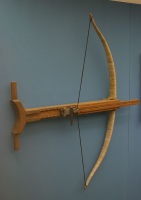








The invention of the crossbow revolutionized warfare, and the technology would spread from Asia through the Middle East and into Europe by the medieval period. In a sense, the crossbow democratized warfare - an archer did not need as much strength or skill to deliver a deadly bolt from a crossbow as he or she would have with a traditional compound bow and an arrow.
The first crossbows were likely invented either in one of the states of early China, or in neighboring areas of Central Asia, some time before 400 BCE. It's not clear exactly when the invention of this new, powerful weapon took place, or who first thought of it. Linguistic evidence points to a Central Asian origin, with the technology then spreading to China, but records from such an early period are too scanty to determine the origins of the crossbow beyond a doubt.
Certainly, the famed military strategist Sun Tzu knew about crossbows. He attributed them to an inventor named Q'in from the 7th century BCE. However, the dates of Sun Tzu's life, and the first publication of his Art of War, are also subject to controversy, so they cannot be used to establish the early existence of the crossbow beyond a doubt.
Chinese archaeologists Yang Hong and Zhu Fenghan believe that the crossbow may have been invented as early as 2000 BCE, based on artifacts in bone, stone and shell that may be crossbow triggers. The first known hand-held crossbows with bronze triggers were found in a grave in Qufu, China, dating from c. 600 BCE. That burial was from the State of Lu, in what is now Shandong Province, during China's Spring and Autumn Period (771-476 BCE).
Additional archaeological evidence shows that crossbow technology was wide-spread in China during the late Spring and Autumn Period. For example, a mid-5th century BCE grave from the State of Chu (Hubei Province) yielded bronze crossbow bolts, and a tomb burial in Saobatang, Hunan Province from the mid-4th century BCE also contained a bronze crossbow. Some of the Terracotta Warriors buried along with Qin Shi Huangdi (260-210 BCE) carry crossbows. The first known repeating crossbow was discovered in another 4th century BCE tomb in Qinjiazui, Hubei Province.
Repeating crossbows, called zhuge nu in Chinese, could shoot multiple bolts before needing to be reloaded. Traditional sources attributed this invention to a Three Kingdoms period tactician named Zhuge Liang (181-234 CE), but the discovery of the Qinjiazui repeating crossbow from 500 years before Zhuge's lifetime proves that he was not the original inventor. It seems likely that he improved significantly on the design, however. Later crossbows could fire as many as 10 bolts in 15 seconds before being reloaded.
Standard crossbows were well-established across China by the second century CE. Many contemporary historians cited the repeating crossbow as a key element in Han China's Pyrrhic victory over the Xiongnu. The Xiongnu and many other nomadic peoples of the Central Asian steppes used ordinary compound bows with great skill, but could be defeated by legions of crossbow-wielding infantry, particularly in sieges and set-piece battles.
Korea's King Sejong (1418-1450) of the Joseon Dynasty introduced the repeating crossbow to his army after seeing the weapon in action during a visit to China. Chinese troops continued to use the weapon through the late Qing Dynasty era, including the Sino-Japanese War of 1894-95. Unfortunately, crossbows were no match for modern Japanese weaponry, and Qing China lost that war. It was the last major world conflict to feature crossbows.